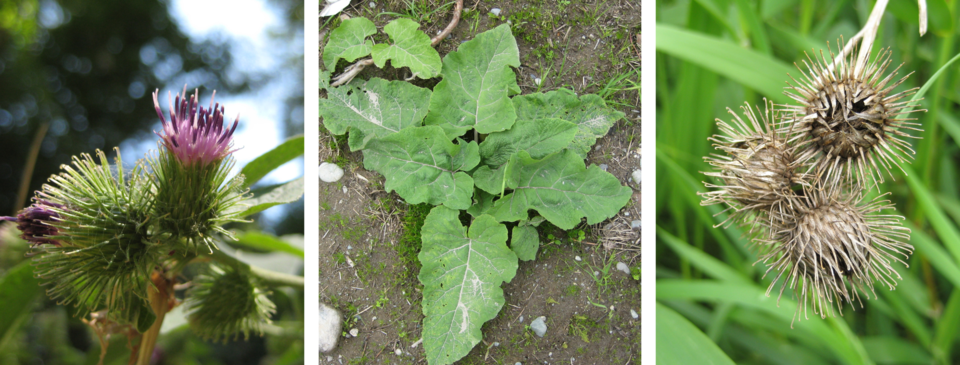Do you ever come home from your daily mental-health walk with the bottom of your sweater caked in pesky burs that take forever to pick out of the fabric and won’t come out in the wash (ask me how I know)? Or even worse, have you ever had to spend hours picking burs out of your pet’s otherwise adorably fluffy tail after zooming through a field?
Then you’ve had the displeasure of meeting common burdock, an invasive plant best known for its globe-shaped, prickly seedheads. Burdock was first reported in North America in the 1600s; originally from Europe, it is now commonly found in Whistler.
Do you recognize this?
Common burdock is easily recognizable by its large, heart-shaped leaves and purple, bristled flowers. It is sometimes confused with rhubarb, but the former has matte leaves and a woolly underside, whereas the latter has shinier leaves, red stems, and cones of cream-coloured flowers.
Why do we care?
I want to acknowledge that common burdock has some practical uses. Herbalists employ it in traditional Chinese medicine, and the taproot is also consumed as a root vegetable in Japanese cuisine.
Nevertheless, burdock infestations can become a “sticky” issue: its large leaves can outshade and outcompete native plants, leading to biodiversity loss; there have also been instances of small birds and bats getting stuck in burs. Moreover, common burdock hosts powdery mildew and root rot, which damage crops and ornamental plants.
How you can help
The clingy burs burdock uses to spread its seeds may be a clever adaptation, but don’t be fooled—burdock is not infallible. By controlling the seed spread and digging out the plants, we can noticeably reduce the prevalence of burdock in Whistler.
Case in point: The Sea to Sky Invasive Species Council (SSISC) has worked with volunteers to remove burdock from the Valley Trail and other public sites since 2018, through a program called Banish Burdock. Thanks to the work of some dedicated volunteers, several areas are now showing very little burdock regrowth. There is hope, and we are seeing native plants repopulate many of these former “burdock deserts.”
The beauty of Banish Burdock is it allows you to juggle your busy life and hectic work schedule while still supporting Whistler’s biodiversity. You see, Banish Burdock volunteers select a burdock patch to “adopt” for the whole summer, so they can work on controlling the pesky invasive when they please.
The other advantage of Banish Burdock is you don’t need to be a plant nerd, seasoned landscaper, or conservation expert to get involved. All you need is some elbow grease and a willing attitude; the SSISC staff will teach you everything you need to know and even lend you some tools for the summer.
Don’t be ‘prickly’; it’s your responsibility
To say Whistler’s natural environment is special is beyond cliché, but let’s not take it for granted. As stewards of this land, it is our responsibility to tend to it—which, in my opinion, includes controlling the invasive species that threaten it.
Visit ssisc.ca/burdock to learn more about how you can help.
Naturespeak is prepared by the Whistler Naturalists. To learn more about Whistler’s natural world, go to whistlernaturalists.ca.




